Anxiety and fear can manifest in various forms and behaviors in cats, from peeing outside the litter box to excessive grooming, to hiding away from the world. Understanding what causes these behaviors is the first step in effective cat training and improving their overall well-being.
Fear and anxiety in cats are different conditions; the difference between them depends on the cause and how long the behavior lasts. Anxious cats can become overly clingy or withdrawn and might groom themselves excessively, causing bold patches, and sometimes relieve themselves outside their little box. On the other hand, fearful cats often show they’re afraid of something by hiding away, flattening their ears, fluffing out their tails, refusing to make eye contact with you, and behaving skittishly.
The importance of understanding your cat’s emotional states can’t be overstated. Read this comprehensive guide to learn how to help your cat overcome her fear and anxiety, leading to a longer, healthier, happier life for your furry friend!
What Is The Difference Between Cat Anxiety And Fear?
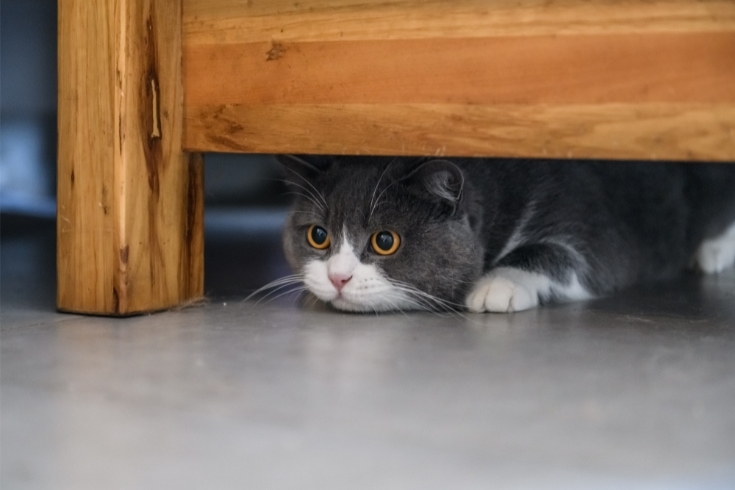
The difference between cat anxiety and a fearful cat is that anxiety is typically caused by the anticipation of an event that might occur in the future, whereas fear is triggered when the threat is imminent.
There are varying degrees of anxiety, ranging from mild to severe, but fear tends to be an all-or-nothing emotional state.
Keep reading to learn more about the difference between cat anxiety and fear.
What Is Cat Anxiety?
Cat anxiety refers to a cat’s feelings of apprehension, usually when she’s anticipating some sort of threat. Anxiety is not generally a big deal for your cat, although if the behavior becomes chronic, health problems can result,
What Are The Signs Of Anxiety In Cats?
The signs of cat anxiety vary, depending on how anxious the cat feels. Signs of anxiety in cats can be mild, moderate, or severe, typically depending on the cause.
Mild Signs Of Cat Anxiety
The early signs of cat anxiety are often so mild they are barely noticeable. However, once you get to know your cat, you should be able to spot when trouble is brewing and take steps to prevent her anxiety from escalating.
Avoiding Eye Contact
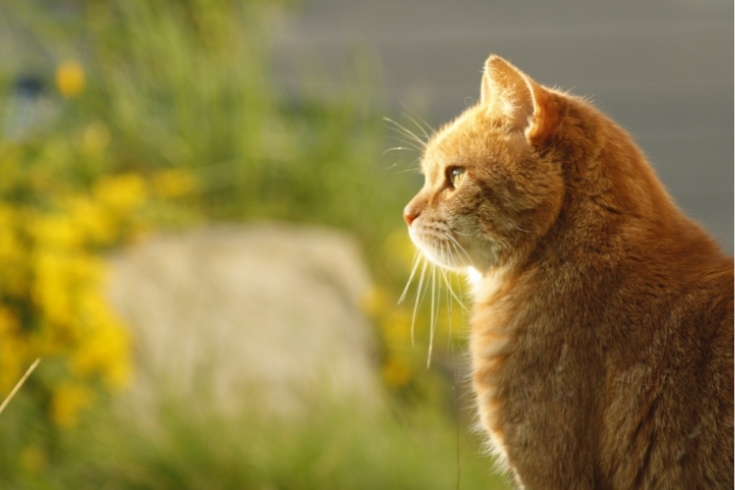
If your cat is feeling anxious about something, she will avoid making eye contact with you. That’s because looking someone or another animal directly in the eyes is often viewed by cats as a confrontational act.
Shifting Body Or Head Away
When your cat is feeling anxious, she might turn her head away or move her body to make herself look smaller and less confrontational.
Holding Their Tail Close To Their Body
Your cat might clamp her tail close to her body to protect it from a perceived threat.
Slight Tail Flicking
In the cat’s body language, slight tail flicking indicates irritation or anxiety, so if you see your cat exhibiting this behavior, you will know she is not feeling entirely happy.
Partially Dilated Pupils
A state of heightened awareness or anxiety puts your pet in fight or flight mode, which causes a rush of adrenaline to the kitty’s eye muscles, causing her pupils to dilate partially.
Moderate Signs Of Cat Anxiety
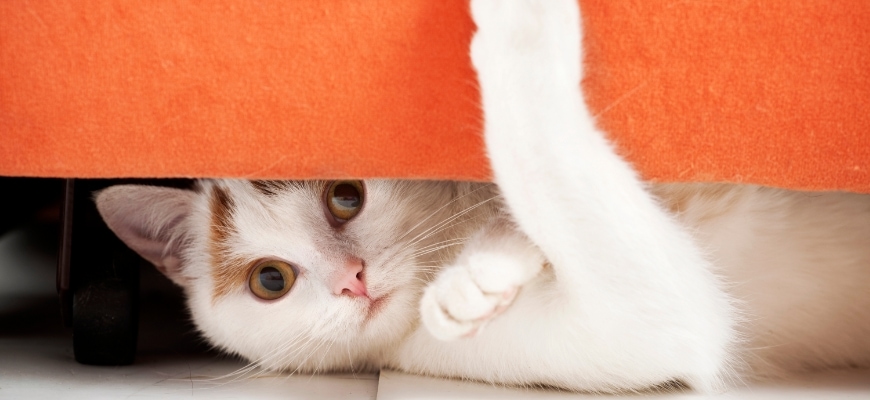
If your cat continues to feel anxious and the perceived threat worsens, she might display signs of moderate anxiety.
Ears Partially To The Side
A moderately anxious cat often folds her ears slightly to one side, typically right before she flattens them against her head.
Increased Dilation Of The Pupils
As explained above, dilated pupils result when the cat enters fight or flight mode. That happens because of a sudden spike in adrenaline, causing the muscles in the cat’s eyes to react, dilating the pupils.
Increased Respiratory Rate
Anxious cats will often breathe more quickly and have an increased pulse rate in readiness for flight. When the respiratory rate increases, more oxygen and adrenaline are circulated around the cat’s body, providing it with the energy it needs to flee.
Looking At The Stimulus
The cat will often look at whatever is causing her to feel anxious, such as an approaching stranger. Observing a would-be predator gives the cat a chance to work out whether to run away or prepare to fight.
Holding Their Tail Tight Against Their Body
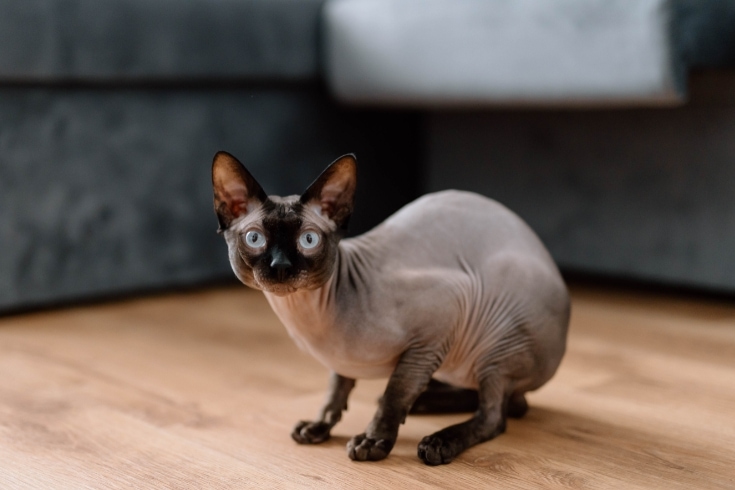
As mentioned above, an anxious cat will hold her tail tight against her body to protect it from potential damage should a real threat emerge.
Crouching And Leaning Away
When a cat is anxious, she will often adopt a crouching pose, leaning away from whatever it is that is upsetting her.
Severe Signs Of Cat Anxiety
If you don’t remove the cause of your cat’s anxiety or take her to a place where she feels safe and comfortable, more severe signs of anxiety might develop.
Trying To Escape Or Completely Freezing In Place
Your cat might try to bolt to safety, or she could completely freeze, hoping that the cause of her anxiety simply goes away.
Fully Dilated Pupils
A severely anxious cat will be fully in fight or flight mode, and all that excess adrenaline will cause her pupils to dilate fully.
Holding Their Ears Back
When a cat feels very anxious, she often holds her ears back against her head. It’s thought the cat does this to protect her vulnerable ears from potential injury by an attacker.
Hair Standing Up
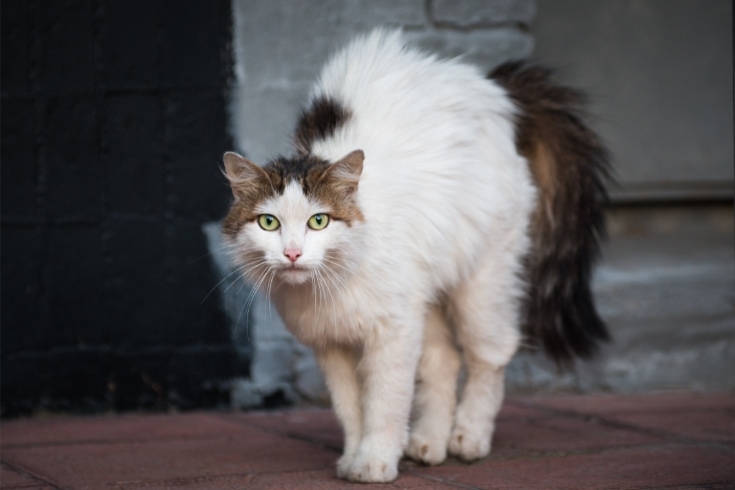
When a cat is very anxious and verging on being afraid, her hair might stand on end. The scientific name for that phenomenon is piloerection, which is caused by a hormone cascade that makes tiny muscles at each hair base contract, lifting the hairs away from the cat’s body.
Staring
If your cat fixes you with a direct stare, wide eyes, and a rigid posture, that’s often a sign of fear or aggression. That posture and look is your cat’s way of letting you know that she is ready to defend herself or take flight, depending on the nature of the perceived threat.
Aggression
If the cat is not in a position to run away from the cause of her anxiety, she might become aggressive, hissing, growling, or even swatting her paw to ward off a threat.
What Causes Anxiety In Cats?
The cause of cat anxiety is generally down to a number of things in the cat’s immediate environment.
The cat could become anxious because of loud noises that she doesn’t understand, a house move and the subsequent changing environment, being separated from her owner, being in conflict with a housemate, and a lack of socialization when she is a kitten.
Environmental Changes
Changes to her familiar surroundings lead to feelings of insecurity and anxiety for your pet, and one of the main causes of anxiety in cats is environmental changes, such as moving home or simply rearranging your furniture.
Lack Of Socialization
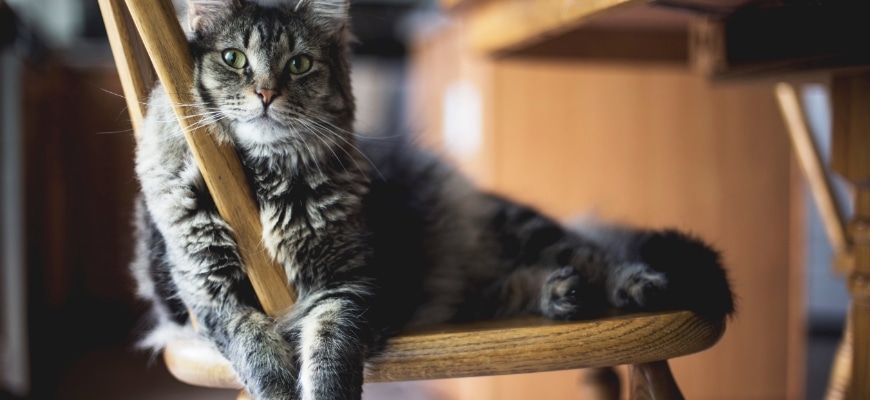
If your cat has not been socialized properly, meeting new people and other animals can be extremely stressful for her.
Separation
Some cat breeds, such as Siamese, can suffer from separation and anxiety, which makes them stressed and anxious when separated from their owners.
Loud Noises
Most cats will startle at loud noises, and if you live near a main road, for example, the constant traffic passing by outside can stress your cat and leave her with chronic anxiety.
Inadequate Hiding Places
When a cat feels anxious or afraid, she will look for somewhere to hide where she feels safe. If you don’t have enough hiding places around your home where your cat can take refuge, that can cause her to feel anxious.
Conflict With Other Animals
In a multi-pet home, it is not uncommon for cats to become anxious, especially if they are in competition for food and other resources.
When I first brought my puppy home, both my cats were anxious about their new housemate, although that gradually improved, and now they get along fine together, and any signs of stress have disappeared completely.
Medical Conditions
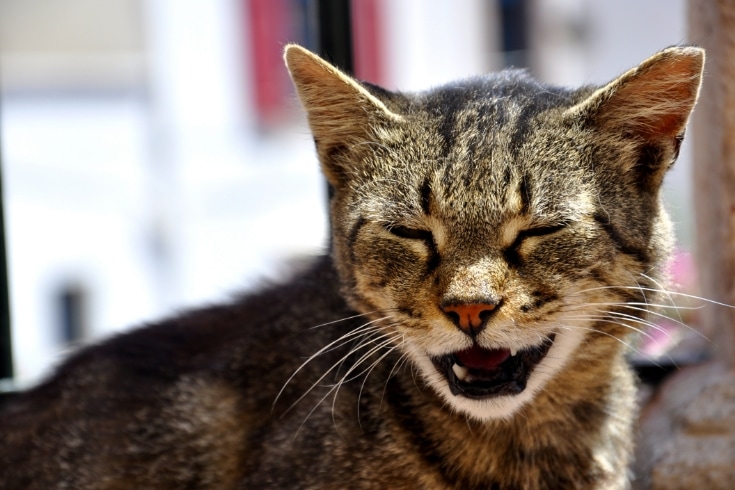
Some medical conditions, such as cognitive dysfunction or feline dementia, can leave a cat feeling stressed and anxious.
Routine Changes
Cats are creatures of routine and like to know when it’s feeding time, playtime, time to go out, and time to rest. If you change your cat’s routine, that can leave her feeling anxious and uncertain.
Lack Of Mental Stimulation
Even if you own a senior cat, she still needs mental stimulation to keep her mind active and distract her from potential sources of stress and anxiety.
Past Trauma
Past traumatic experiences can spill over into your cat’s present daily life and trigger episodes of anxiety. For example, if your cat was previously involved in a road accident, the sound of cars outside your home can make her feel anxious and afraid.
Unfamiliar People
If a cat has not been socialized from an early age, unfamiliar people visiting your home can be a source of stress and anxiety for your pet.
Veterinary Visits
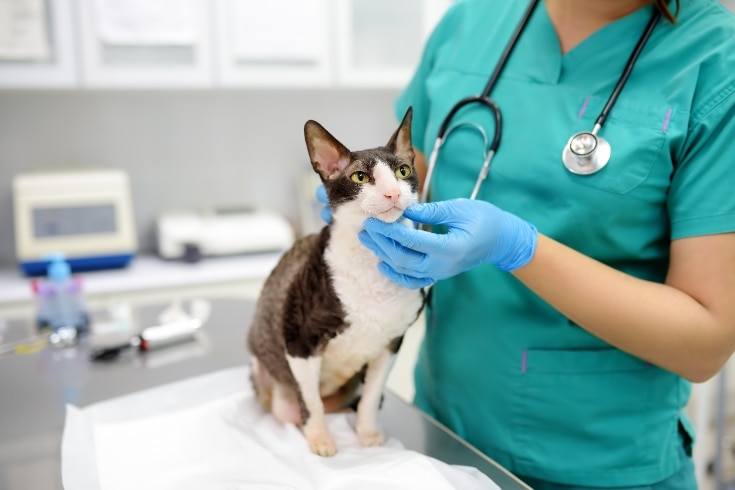
Few cats enjoy paying a visit to the veterinary surgery, and many cats become anxious as soon as they arrive in the consulting room waiting area. That’s probably because trips to the vet usually involve needles or only happen when the cat is sick.
Unwanted Attention
Although some cats love to be petted and fussed over, others prefer to be left in peace, and unwanted attention from children and visitors to your home can be a source of anxiety.
Change In Family Dynamics
A big cause of anxiety and stress in cats is a change in your family dynamics. For example, someone the cat was previously very closely bonded with could leave to go to university, or a new baby might arrive in the household, disrupting the cat’s routine.
Travel
Just like people, some cats get travel sick when riding in a car, leading to stress and anxiety. You can help prevent that by using positive reinforcement techniques to train your cat to travel in her cat carrier.
Lack Of Vertical Space
Cats naturally enjoy climbing and love to sit on a high perch where they have a good view of their surroundings and can keep an eye out for potential threats approaching. If your cat cannot access vertical space, she might become anxious.
The easiest way to prevent your cat from becoming anxious due to a lack of vertical space is to provide her with a cat perch to sit on.
What Cat Anxiety Treatments Are Available?
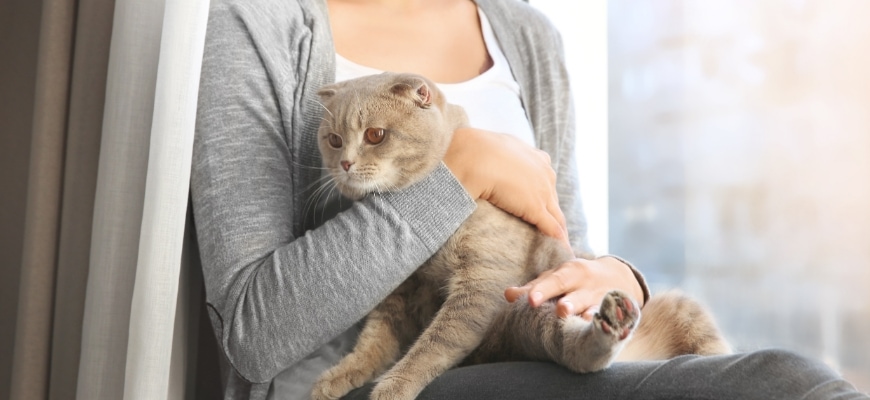
Cat anxiety treatment varies depending on the cause of your pet’s problem, and there are various ways of treating cat anxiety. Understanding the available treatments can be crucial for your pet’s well-being.
Here’s an overview of how to treat cat anxiety naturally.
Environmental Enrichment
Providing an enriched environment means giving your cat various forms of physical and mental stimulation. That can include toys, climbing structures, interactive games, scratching posts, and opportunities to watch birds or other animals from a window. An engaging environment can distract cats from potential causes of stress and anxiety and keep their minds active, reducing feelings of boredom or frustration.
Pheromone Therapy
Synthetic feline facial pheromones can mimic the natural chemicals that cats produce to mark their territory as safe. Using these pheromones in sprays, diffusers, or wipes around your home can help create a feeling of safety and familiarity for your cat, potentially reducing stress and preventing anxiety.
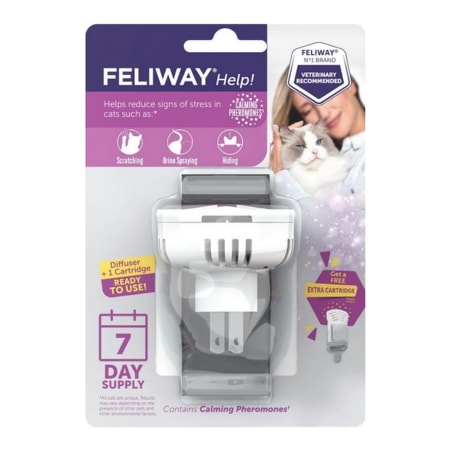
Medication
In more severe cases of anxiety, your vet might prescribe anti-anxiety or antidepressant drugs for your cat. These medications can be helpful in curing the symptoms of anxiety but should be used as a last resort and always under the guidance of a vet.
Behavioral Training
Behavioral training involves using positive reinforcement to teach your cat to associate potentially stressful situations with something positive, such as treats or a fun game with a favorite toy.
Cognitive Behavioral Therapy (CBT)
Cognitive Behavioral Therapy focuses on changing your cat’s negative behavioral patterns and thoughts. That can involve exposing your pet gradually to a stressor while ensuring she has a positive experience, slowly changing their perception of the stress trigger over time.
Thundershirts And Calming Clothing
Thundershirts are tight-fitting cat sweaters or vests that apply gentle, constant pressure on the cat’s body, much like swaddling an infant. That can have a calming effect on some cats, especially during thunderstorms, fireworks, or other loud events that might distress your pet.
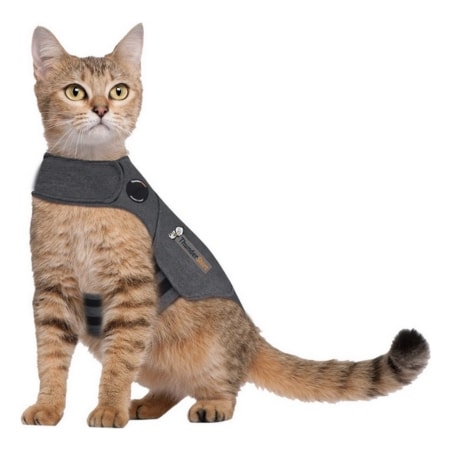
Nutritional Supplements
Some supplements contain L-theanine or tryptophan, which can help manage anxiety in cats, and your vet will give you more advice on what to use to help your pet.
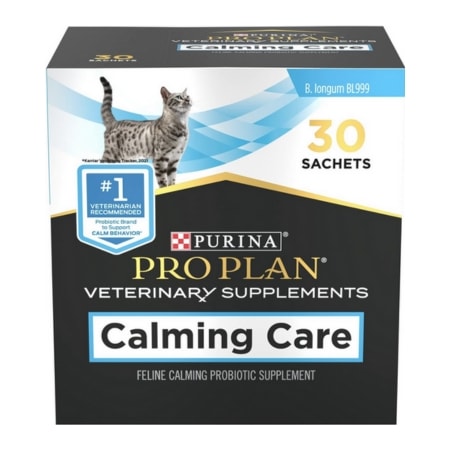
Music And Calming Sounds
Specific music or white noise machines designed for cats can be calming and help relieve anxiety during stressful times. These sounds or melodies are specially formulated to reduce anxiety and create a calming atmosphere for your stressed feline friend.
Routine And Predictability
Cats are creatures of habit and they thrive on a regular routine. A consistent routine, including regular meal times, playtime, and bedtime, can provide comfort and predictability for your cat, reducing the chances of anxiety flare-ups due to unexpected changes.
Socialization And Positive Experiences
Exposing kittens to lots of different experiences, people, and other animals in a positive way can help prevent anxiety in the future. For adult cats, continued exposure to new but safe situations can also help reduce fear and stress, provided you introduce those experiences slowly and carefully.
What Are Fearful Cats?
Fearful cats typically become uneasy or apprehensive because they feel threatened or are placed in an unfamiliar situation where they feel unsafe. Fear is a natural, protective response that could save your cat in a potentially dangerous situation. However, prolonged or chronic fear can cause behavioral problems, including aggression.
In the next part of our guide, we take a look in more detail at the signs of fear in cats and how you can prevent your furry friend from becoming a scaredy cat!
What Are The Signs Of A Fearful Cat?
The signs of a fearful cat are many and varied, and we take a closer look at them below.
A frightened cat might freeze in one place, try to appear smaller by crouching low to the ground, hide, or run away. A more confident cat could fluff up her to appear larger and more threatening, and she might hiss and spit at whatever is making her feel afraid.
Freezing In Place
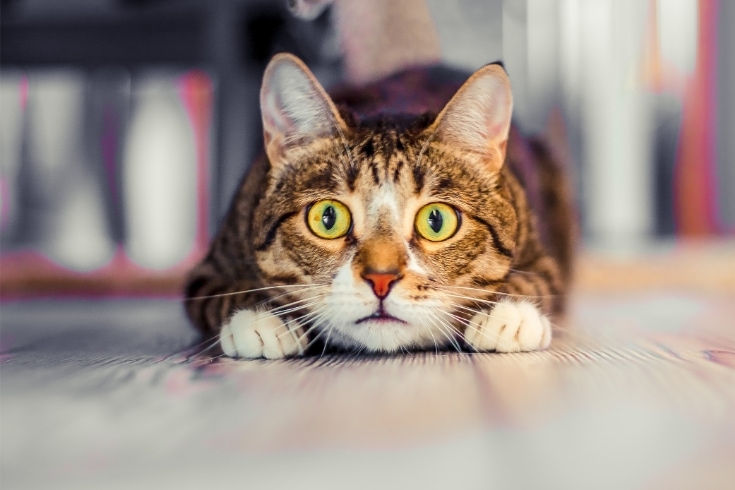
When a cat is frightened, she will often freeze in place apparently too terrified to move. In fact, the cat is likely hoping the cause of her fear will move away without noticing her.
Making Themselves Small By Crouching Low
When a cat is afraid she may Crouch low to the ground in an attempt to make herself look smaller and less threatening, which can help prevent an attack by another cat or a dog.
Running Away
Although cats do run when they’re playing if a cat is afraid, she may run away to try to escape danger. If the cat decides to flee, she will often display several other signs that she is afraid, such as dilated pupils, and puffed-up fur.
Hiding
If your cat has nowhere to run to, she might seek protection by hiding herself instead, working on the principle that if she cannot be seen by a potential attacker, she will be safe.
Arching Their Back And Puffing Up Their Fur
When a cat feels threatened by another cat or a dog, she will often arch her back and puff up her fur to make herself look bigger and more intimidating to her would-be attacker.
Wide Eyes With Big Pupils
As explained earlier in this piece, when cats are stressed and/or fearful, their pupils dilate because of the increased adrenaline rush through their bodies.
Tucking Their Tail Under Them
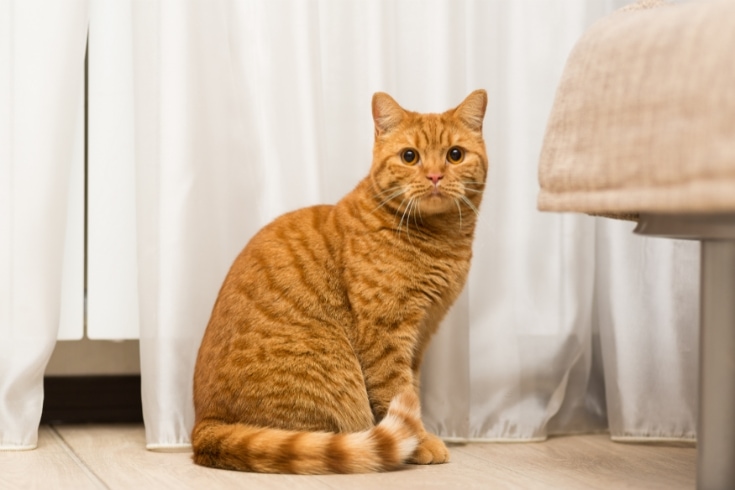
A frightened cat often tucks her tail underneath her to protect her vulnerable rear end from an attacker. With the cat’s tail tucked out of the way, it’s less likely to be grabbed by an attacker and injured.
Moving Their Ears Quickly
In an effort to hear more of what is going on around her, a frightened cat will often move and flick her ears quickly. That enables the cat to hear more clearly any sounds that might indicate what is the source of her fear.
Hissing Or Spitting
When your cat feels threatened by another cat or dog, is cornered, and has no clear escape route, she will often hiss or spit as a warning to the aggressor.
Scratching Or Biting
As a last result, a frightened cat might scratch or bite. That doesn’t mean the cat is aggressive in nature, but she could just be frightened at that moment.
Peeing Or Pooing Outside Their Litter Tray
If a cat is frightened and unsure of her environment, she might pee or poop elsewhere in your home so that she doesn’t have to sit exposed on her litter tray where she could be attacked.
What Are The Causes Of Fearful Behavior?
The causes of fearful behavior in cats depend on where the cat is at the time, what is going on around her that could frighten her, and associations the cat might have with past trauma.
A Particular Person
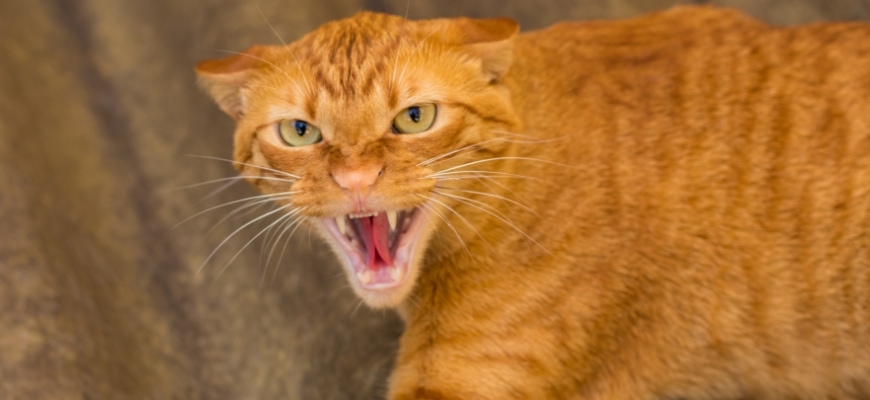
If a particular person has abused or physically punished the cat, she might be frightened when that person is around her.
A Stranger
Some cats, especially former strays, have negative associations with strangers, typically because the cat has been chased away from a potential shelter or food resource while living on the streets.
Another Animal
Some cats are aggressive toward other cats, and you have no doubt heard feline squabbling outside your home at night. However, I once had a cat who was terrified of the sheep that lived in a field opposite my home, and she was reluctant to go outside when the sheep were nearby.
A Child
Kids can be clumsy and noisy around animals, and that can frighten a cat, especially if she has had her tail or fur pulled by a child in the past.
Loud Noises
Loud noises, such as fireworks, thunder, and construction, can be terrifying for a cat, so be sure to provide your feline friend with plenty of hiding places and distractions during stormy weather and on the 4th of July.
Lack Of Socialization
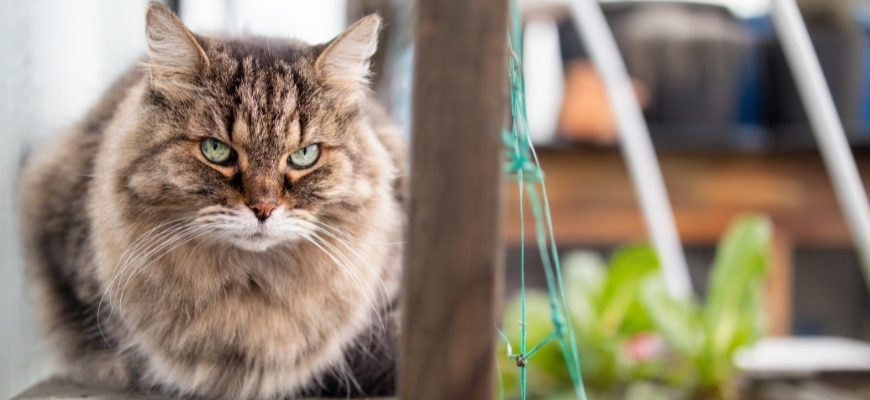
Cats that are poorly socialized often become frightened in unfamiliar situations. For example, if a cat is not used to boisterous, noisy children, she may hide away when exposed to noisy kids visiting your home..
Negative Experiences
Past negative experiences can lead your cat to associate those same experiences with something unpleasant, even though she has nothing to be afraid of in the present.
Genetics And Temperament (Inherited Traits)
Some cats are naturally programmed to be more timid and prone to fear than others. My two cats are brother and sister. My boy cat is lazy and not fazed by anything, but the girl is afraid of her own shadow!
Pain Or Discomfort
If an animal is in pain or discomfort, it will feel vulnerable and afraid. So, if your previously chilled-out cat suddenly becomes anxious and fearful, I advise you to have her checked over by your vet in case an underlying health condition is to blame for her change in behavior.
Previous Trauma
Cats that have previously been traumatized in a particular situation might find the same situation is a stress trigger, even though they are in no immediate danger.
Feeling Trapped
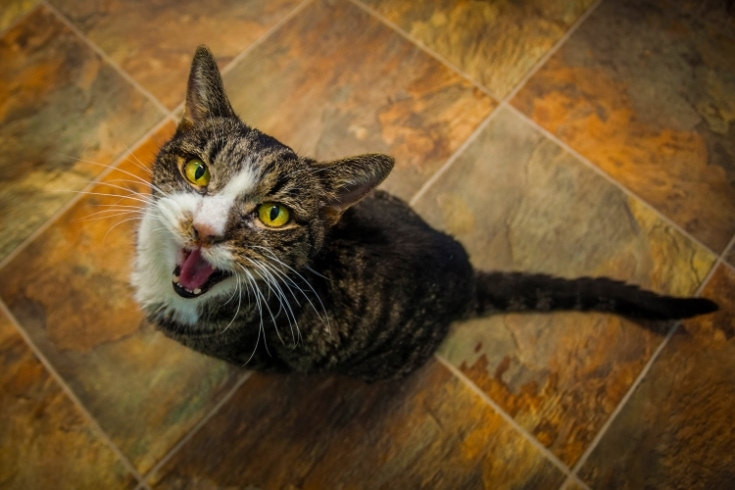
If a cat feels that she is trapped with no obvious escape route, that will lead to fear. One way in which cats can escape something that is threatening them is to bolt and run away. So, if the cat has no clear escape route she can use, that will make her feel even more afraid.
Negative Association (Punishment)
You should never punish your cat verbally or physically, as that will establish a negative association with you and whatever behavior she was exhibiting at the time of the punishment.
Invasion Of Territory (Territorial Behavior)
Cats are quite territorial animals, and your cat might object to a strange cat or animal passing through her backyard. The cat perceives her backyard as her territory and any other animals or cats she encounters there will probably be perceived as threats to be chased away.
Lack Of Positive Reinforcement (Absence Of Rewards)
Although it has not been my personal experience, some cat owners report their cats show signs of fear, simply because of a lack of positive reinforcement and the absence of rewards for training.
How Do You Manage Fearful Cats?
Treating a fearful cat takes much patience, time, and consistency from you. You first need to establish what is causing your cat to feel afraid, then you can work out a suitable management program.
Make Sure They Have Their Own Space
Cats do not like to feel trapped or hassled, so be sure to provide your cat with her own space in your home, where she can escape from the hustle and bustle of daily life.
Avoid Or Reduce The Things That Scare Them
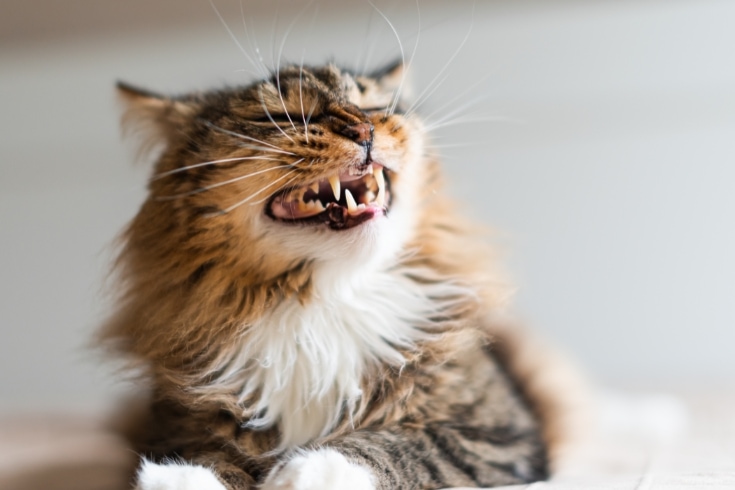
Once you’ve worked out what your cat is afraid of, do your best to reduce those things, and if you can avoid exposing your cat to them completely, that is even better.
Give Them Space
A cat is less likely to be anxious or fearful if she has plenty of space to live in and doesn’t feel crowded or pressured by her housemates.
Close The Curtains And Try Playing Music Or The TV
On stormy nights or when fireworks are being set off outside your home, try closing the curtains to shut out bright lights, and try playing music or switch on your TV to drown out the noises that are frightening your cat.
Always Stay Calm
When your cat is anxious or afraid, try to stay calm and be patient with her. Remember that fear is a perfectly natural response, and your cat is not being naughty.
Try To Stick To A Routine
Your cat will feel more secure and less prone to anxiety and fear if she has a regular routine for her day, including feeding, training, exercise, and going outside.
Introduce New Things Slowly
Gradually introduce your cat to new things, including people and other pets, so that she has time to adjust and won’t be frightened or anxious.
Keep A Few Litter Trays Inside
If your cat is afraid to go outside, keep a few little trays inside your home so that your cat can stay indoors where she feels safer.
Try A Pheromone Plug-In
Pheromone plugins can be very handy in creating a calming atmosphere and preventing your cash from becoming frightened, especially when fireworks are going off outside or during a thunderstorm.
Tcllka Cat Calming Pheromone Diffuser
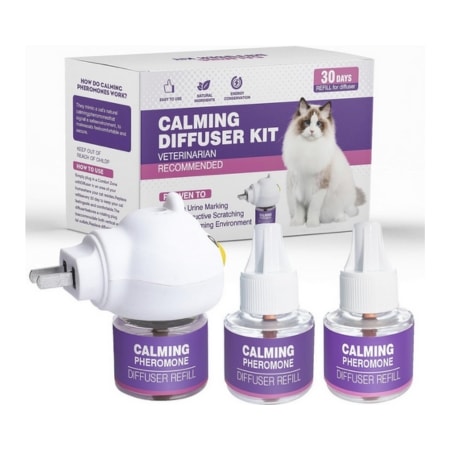
This is a pheromone product that is designed to have a calming effect on your cat, Helping to relieve anxiety and stress.
Feliway
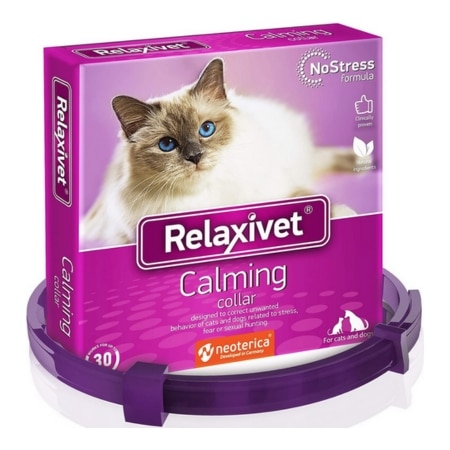
Feliway is probably the most popular pheromone product on the market today, and from personal experience, I can say that it does work to some extent in calming your cat.
Relaxivet
This product comes in a handy collar form that your cat can wear during times of stress, such as car travel and during stormy weather. got to be f****** joking
Make Sure They’re Microchipped And Your Details Are Up To Date
A frightened cat could bolt and become lost, especially if you recently moved home, so it’s a good idea to have your cat microchipped. If your cat is already chipped, ensure your details are up to date so if the worst happens and she goes walkabout, you can be reunited.
Contact Your Vet And An Accredited Behaviorist
If your cat suffers from constant anxiety and seems to be afraid of everything, you should take her to your vet for a health check. If your vet gives your pet the all-clear, discuss the problem with an accredited behaviorist who might be able to help you.
Desensitization
Desensitization can effectively relieve stress, anxiety, and fear in cats. The process works by exposing your cat to her anxiety triggers in a controlled, safe way and rewarding her for remaining calm. Over time, you can increase the exposure to the trigger until your cat remains relaxed.
Calming Aids
Calming aids refers to products designed to alleviate anxiety and fear in fearful cats. These aids, like thunder shirts, utilize gentle pressure to trigger a calming response, reducing stress and promoting relaxation.
Amazon Own Brand

This thunder shirt is designed to keep your cat feeling cozy and calm during stressful situations.
Dentrun
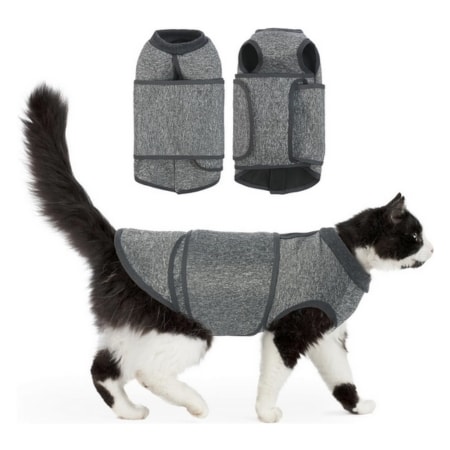
Here’s another shirt to give your cat that comfy, safe feeling in stressful times.
Avoid Force
Never try to force your cat to do something that frightens her, as that will simply reinforce her fears and make the problem worse.
Positive Reinforcement
Positive reinforcement techniques involve rewarding your cat with a treat or a game with her favorite toy when she behaves in the way you want her to.
For example, if your cat remains calm when presented with a scenario that usually frightens her, reward her and praise her. That way, your pet learns that remaining calm and not becoming anxious will earn a pleasant reward.
How Do You Prevent Fear And Anxiety In Cats?
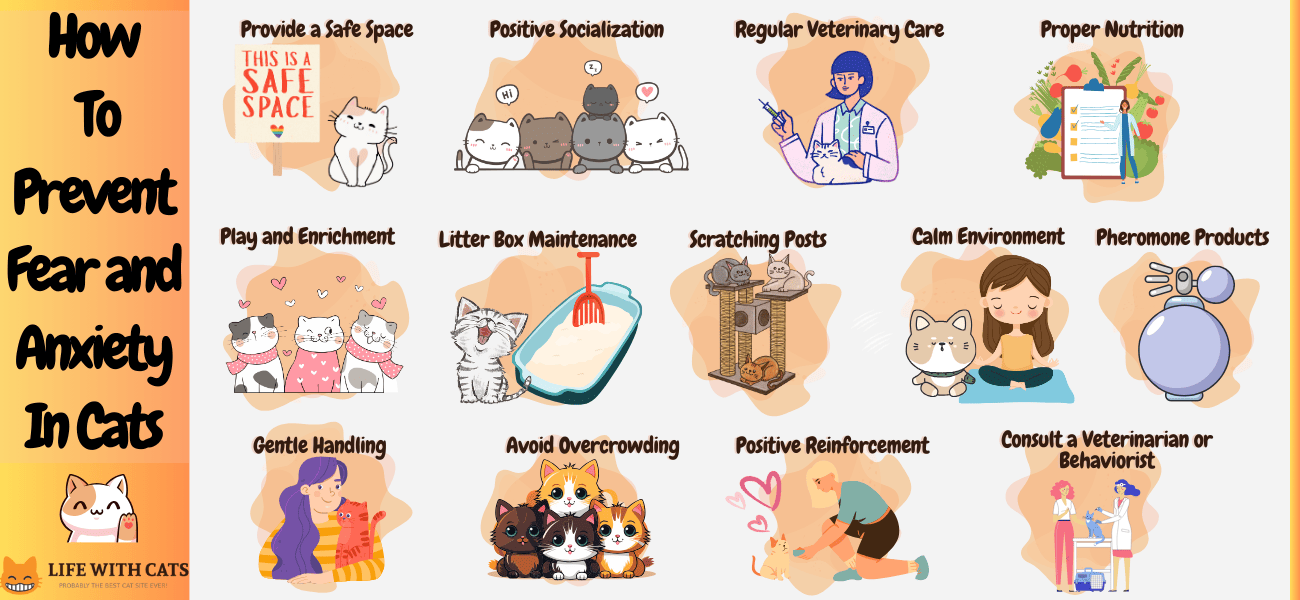
To prevent cat anxiety and allay a fearful cat’s worries, you can use various techniques outlined below.
You can provide your cat with a safe space to hide, ensure she’s properly socialized from kittenhood, give her a balanced diet, use calming aids, handle her gently, and seek veterinary advice if you suspect your pet might be suffering from an underlying health condition.
Provide A Safe Space
As mentioned earlier in this article, you can keep your cat calm and relaxed by providing her with a safe space in your home where she can retreat to when she wants to.
Positive Socialization
If your cat is afraid of strangers and in certain situations, that could be because she hasn’t been socialized positively as a kitten. Take the time to introduce your cat to strangers and other pets in a controlled situation, using positive reinforcement techniques as described earlier.
Regular Veterinary Care
Fear and anxiety can sometimes result from physical discomfort and pain, so have your pet checked over regularly by a vet and keep her vaccinations and parasite control up to date.
Proper Nutrition
A poor diet can cause a cat’s behavior to change, and your pet might feel anxious if she’s hungry. So, be sure to provide your pet with a high-quality diet and balanced nutrition.
Play And Enrichment
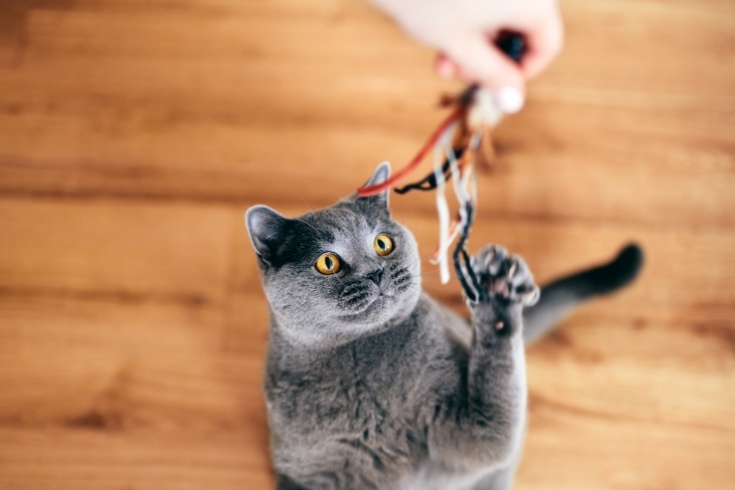
You can prevent your cat from becoming anxious and afraid in certain situations by distracting her with playtime and providing other distractions and enrichments in your home.
Litter Box Maintenance
Cats can get stressed if they don’t have a clean litter box to use, so be sure to keep your cat’s litter tray clean and well-maintained.
Scratching Posts
Cats use scratching as a way of keeping their claws in good order and marking their territory. If your cat can’t indulge in that natural behavior, she might resort to using your furniture or floor coverings. So, be sure to provide your cat with at least one scratching post or more if you have a multi-cat home.
Calm Environment
If you live in a stressful environment, your pets will pick up on that and get anxious too, so try to provide a calm environment for them to live in.
Pheromone Products
As mentioned earlier, synthetic pheromone sprays and plugins can be highly effective in calming your cat and are a godsend during house moves and even on journeys to the vet clinic.
Gentle Handling
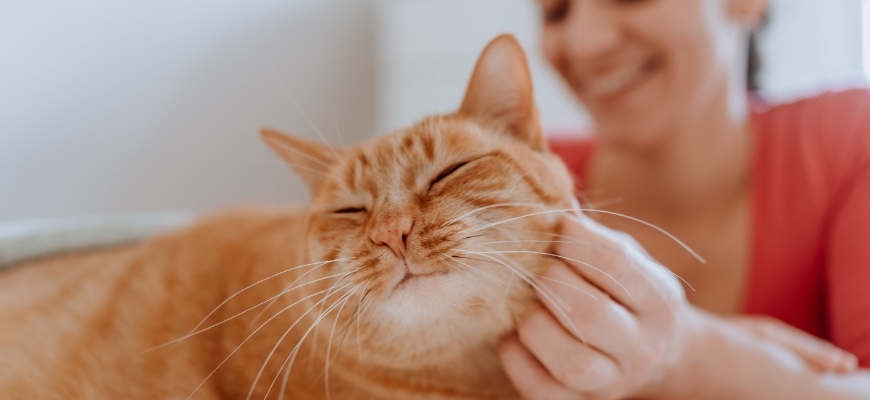
Some cats are sensitive when it comes to being handled, so always touch your cat gently and supervise kids when they’re petting her.
Avoid Overcrowding
Although some cats enjoy the company of others, you can have too much of a good thing! So, try to avoid the temptation of taking on another cat if you already have a houseful.
Positive Reinforcement
When training your cat or simply being around her, always use positive reinforcement to create a positive environment for your pet, especially during times of stress. Positive reinforcement means rewarding your cat for showing certain behaviors, such as remaining calm during stressful situations, so she’s more likely to repeat that behavior in the future.
Consult A Veterinarian Or Behaviorist
Regular veterinary checkups are essential to ensure your cat isn’t suffering from any underlying health conditions, especially if her behavior changes rapidly and without any obvious cause.
If it turns out that your cat is perfectly healthy, it’s a good idea to discuss her behavior with a professional behaviorist.
FAQs
In this part of our guide, we answer some of the most commonly asked questions about fear and anxiety in cats.
Can Anxiety Lead To Health Problems In Cats?
Yes, chronic anxiety can cause health problems for your cat, including hypertension, weight loss, urinary tract issues, and gastrointestinal upsets.
Are There Natural Remedies For Cat Anxiety?
Yes, there are several natural remedies for cat anxiety. However, each cat is unique, so what works for one might not work for another.
- Feliway is a synthetic pheromone spray or diffuser designed to mimic a cat’s natural pheromones and can help reduce stress and anxiety in cats by creating a more familiar or safe environment.
- Many cats find catnip relaxing, although it can make some cats more hyperactive. This herb is available in various forms, such as dried leaves, sprays, and toys.
- Valerian is a herb that has sedative properties and can be given to cats in small amounts. Some cats love the smell and will play with valerian toys, which can also help them expend energy and relax.
- Chamomile is another herb that has calming properties. You can buy toys stuffed with dried chamomile, which work well on some cats.
- In recent years, hemp oil or CBD has gained popularity for use in pets, and some owners claim it helps reduce anxiety in their cats. However, you should always consult with a vet before giving your cat any CBD products, and ensure that it’s a product formulated specifically for cats and is free from THC.
- Gentle petting or cat-specific massage can help calm a nervous cat that isn’t afraid of being handled and touched.
- Collars infused with calming pheromones or essential oils can be worn by the cat and are effective for some kitties.
- Playing soft classical music or nature sounds can have a soothing effect on some cats.
- Consider consulting with a holistic or integrative veterinarian. These guys can advise on additional natural remedies and treatments tailored to your cat.
How Can I Help My Cat During Thunderstorms Or Fireworks?
Pets can be terrified by the sudden loud noises and flashes of fireworks or thunderstorms, but there are several ways you can help your cat cope.
Cats often feel safer and more secure in small, enclosed spaces when they’re afraid, so create a cozy spot for your cat like a box or an open carrier lined with plenty of cozy blankets, and ensure your feline friend can get to it easily. If your cat finds being close to you comforting, have her on your lap and pet her until the storm or firework display is over.
Keep your windows and drapes closed to muffle the sound and block out flashing lights. You could also play soft music or have your TV on at a low volume to provide some background noise. Try to keep calm. Animals can pick up on our emotions, so if you’re calm and composed, your cat might remain calm as well.
It can help to distract your cat with toys or treats, although that’s not effective for all cats. Many vets recommend Feliway in the run-up to fireworks season. Feliway is a synthetic feline facial pheromone product that can help soothe and calm cats and comes in sprays, diffusers, and wipes.
If you know there’s going to be a fireworks display or a storm is forecast, keep your cat indoors well before the event starts. That can prevent your kitty from getting scared and running away.
Can Playtime Really Alleviate Cat Anxiety?
Yes, depending on the cause of the anxiety, playtime with a favorite toy can help distract your cat and make her feel less anxious.
When Should I Seek Professional Help For My Cat’s Anxiety?
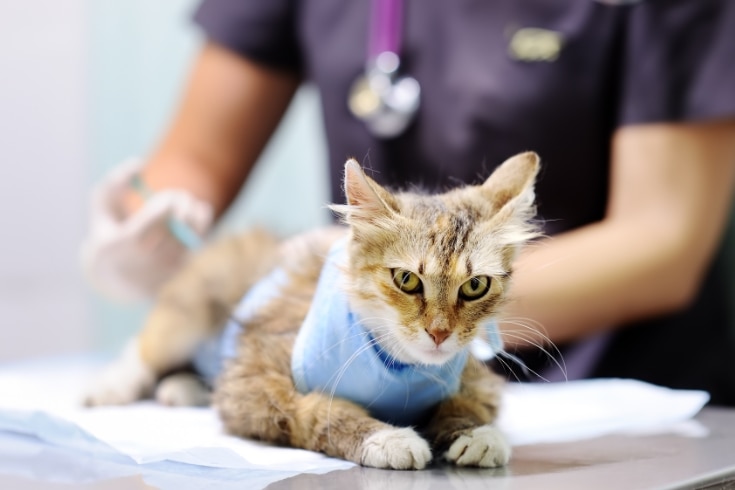
If you can see no obvious cause for your cat’s anxiety, if the behavior becomes chronic, or if she suddenly starts acting scared for no obvious reason, it’s time to seek professional advice from your vet.
In the absence of any health conditions that could be causing the problem, you could ask an animal behaviorist for advice on how you can help your cat.
Can Anxiety In Cats Be Managed Without Medication?
Yes, depending on what’s causing your pet to be so stressed and anxious, you can often manage the condition without resorting to medication. However, drug therapy might be necessary if your cat’s anxiety is caused by pain or discomfort, drug therapy might be necessary.
Can Cat Breeds Influence Anxiety Levels?
Yes, some cat breeds are more predisposed to anxiety than others. Exotic breeds are more likely to be stressy cats, including Siamese and Burmese, who tend to have higher social needs and a stronger desire for their owner’s attention.
How Important Is Routine In Managing Feline Anxiety?
Cats are very much creatures of habit, and the security and predictability a routine creates are essential for keeping them calm and relaxed.
Conclusion
Cats can become anxious and afraid under certain circumstances, such as during storms, following a house move, and when their home dynamic changes. You should learn to recognize the signs of anxiety and fear in your cat so that you can help her overcome them. Acknowledging and alleviating feline anxiety is crucial for your cat’s health and well-being, and a stressed cat often has a shorter life expectancy than one who enjoys a more relaxed lifestyle.
The best way to prevent your cat from becoming stressed is to provide her with a comfortable, safe home with a quiet place where she can relax and feel secure during times of stress. During storms and when fireworks are going off, keep your cat indoors with the windows closed and the drapes drawn.
Keep up with regular veterinary health checks to be sure your cat isn’t suffering from underlying health problems that could be causing her pain and discomfort. And if your cat’s behavior suddenly changes for no obvious reason, consult your vet for advice.